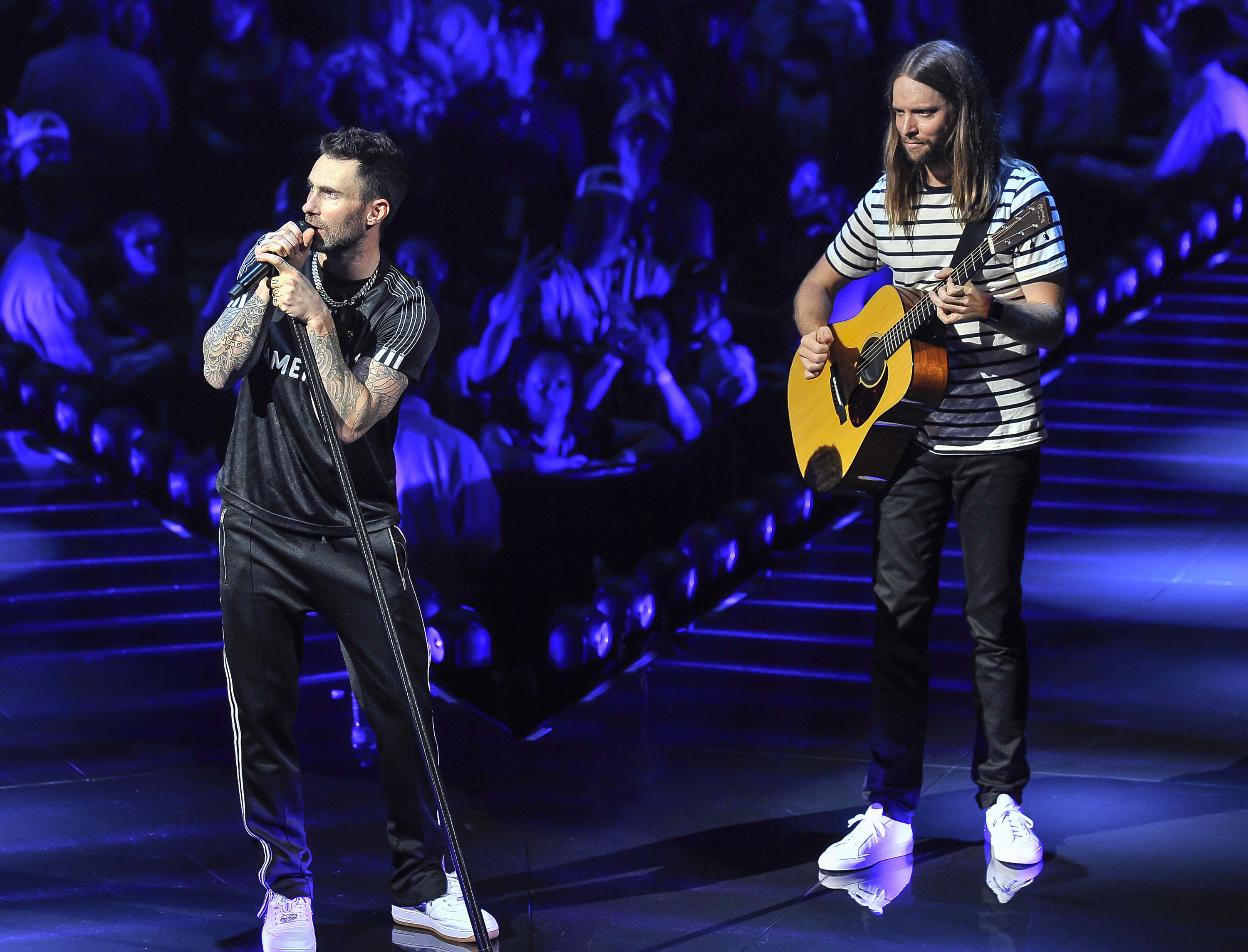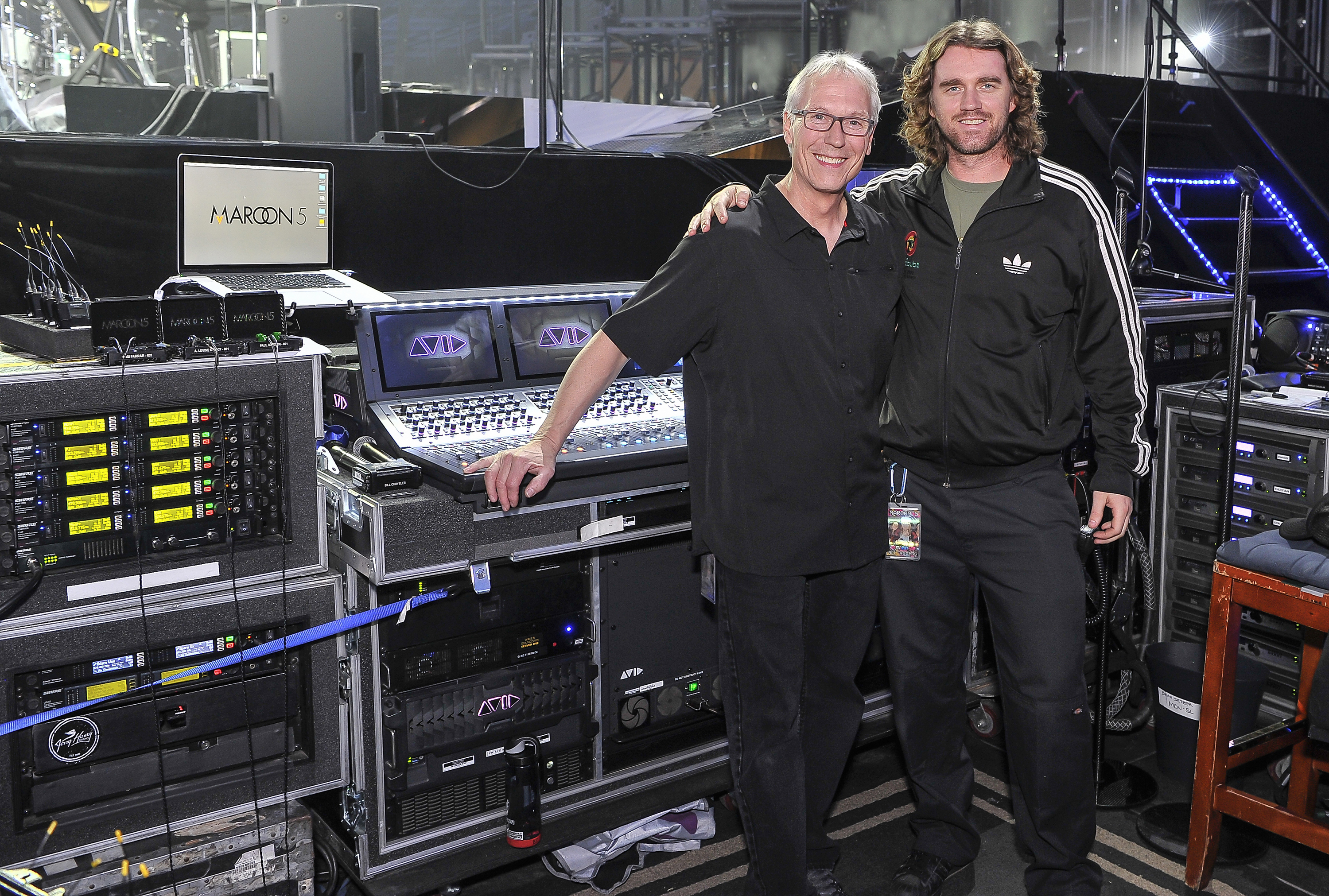
Mix caught the Maroon 5 Red Pill Blues Tour at the Golden 1 Center in Sacramento, Calif., in early June, with audio production provided by Sound Image of Escondidio, Calif. With the band being Shure endorsers, Maroon 5 lead singer Adam Levine uses the Shure Axient system and sings into a black SM 58 capsule.

FOH engineer Vincent Casamatta, pictured at left with systems engineer Vic Wagner, has been using the DiGiCo SD5 for the past decade. “Whatever aesthetic I’m going for, whoever the artist, it gives a clean and transparent starting point, which is especially useful when I’m working with an artist like Maroon 5 that have six albums spanning two decades. Styles and sounds change over time,” Casamatta says. “We have the Waves SoundGrid server running up on the SD5, and, in general, anything that I need to automate goes on the server and anything that is static for the entire show I have in my outboard rack.”
With Maroon 5, Casamatta is using plug-ins mainly for bus compression. “I try and look at compression as an effect in its own right,” he says. “I have to mix in acoustically challenging places like arenas, so adding in reverb or time-based effects doesn’t always help my cause. But compression can add harmonics or make an element jump through a mix in an effortless way without eating up headroom or adding cloudiness. It’s a way to say the most by doing the least, which is helpful in any live setting.

“Adam’s vocal first goes to the Tube-Tech CL 2A—this compressor is the sound of Adam’s vocal live—fast attack and release, with a low threshold and his vocal just sits right in the mix,” he explains. “He also gives a lot of output, so I’m not using compression to correct his vocal—I’m using it as an effect again. I also rely on the Bricasti M7 reverb. It’s really cool for one reason: when I have it on in the mix, I don’t always notice it, but when it’s bypassed, you can feel his vocal just sink down into the mix.”
It can be even more of a challenge when Levine sings in front of the P.A. on the ramp, as he does for nearly the entire show. “All the bleed of my entire mix is going right into his vocal,” Casamatta says. “I don’t want to subdue the band in the mix to keep the bleed out of Adam’s vocal mic, so I’ve been using the Neve 5045 Primary Source Enhancer to pull the room sound out of his vocal. That particular Neve unit makes it super easy to control room bleed into his mic, which in turn means I’m not fighting against myself the whole show.”

Monitor engineer Bill Chrysler, left, with monitor tech Marcus Douglas, is mixing on an Avid VENUE S6L-32D with the latest version of Waves SoundGrid. Most of the plug-ins he’s using are right on the console, with the exception of Adam Levine’s vocal reverb, which is a Waves TrueVerb.
“No one in the band gets too elaborate or overly technical with their in-ear mixes,” Chrysler says. “They each get nice full mixes with a bit of themselves on top. They know what they want to hear and communicate that clearly to me. These guys work hard but know how to have a good time. They’re a really great band to mix and tour with.” With the exception of the bass rig, all the band instrument speakers are off stage. Everyone on stage except bassist Mickey Madden is on IEMs.

The L-Acoustics P.A. system consists of: main hangs (14x) K1 and (6x) K2 per side; side hangs (16x) K2; flown subs (12x) K1SB; aux (8x) K1 and (12x) K2; ground subs (center, spaced end-fire array) (16x) SB28; flown “center” pit fill (8x) K2s.
Systems engineer Vic Wagner employs Soundvision, L-Acoustics’ proprietary acoustic prediction software, and Rational Acoustics Smaart 8 to align the system each night. “All of the tuning characteristics of the system occur internally in each LA8 amplified controller using LA-Network Manager IP-based control software,” he says. “With L-Acoustics K2, rigging flexibility is almost infinite, allowing us to hang a unique center cluster pit fill above the GA pit audience area. The horizontal directivity of the K2 elements allows me to control HF dispersion to keep energy consistent in the triangular-shaped audience area and off the deck/runway, where headroom is appreciated.”

Guitarist James Valentine uses a Suhr cabinet (above) for a dry signal and the L/R Matchless cabinets for stereo effects. “We use a Royer 121 on the Suhr and SM57s on the Matchless cabs,” Chrysler says. Valentine’s rack setup consists of an Avalon rack, City Baby rack, Fractal Axe-Fx XL, RJM rack, two Suhr amps and two Matchless amps.

Matt Flynn’s drum kit mics are: on kick, a Beta 91A inside and a Beta 52 outside; snare is a SM 57 on top and AKG 414C on bottom; hi-hat and ride are Neumann KM 184s; toms are Shure Beta 98As; and overheads are Audio-Technica 4050s. Radial JDI boxes are used on the E drums.

Keyboardist PJ Morton’s setup consists of a Yamaha XF8, Yamaha XF7, Nord C2D, Nord Wave and Micro Korg CL+, all patched into the system through two Radial JD6 single-rackspace DIs.

Multi-instrumentalist Sam Farrar sits stage right with a setup that includes a Mac Plus for samples, an SPD pad, acoustic guitar, bongos and a shaker. He uses a Native Instruments Maschine controller and a Novation Launch Pad Pro to play clips through Ableton. He also has a Roland SPD-SX.







